 david coombe | history
david coombe | history
SUMMARY: Some of S.T. Gill's pictures were used by George French Angas in London in 1846-1847 – in his Egyptian Hall exhibition and in his books South Australia Illustrated and Savage Life and Scenes. In two instances he acknowledged T.S. Gill as the artist; he claimed authorship of the remainder. Angas used Gill's pictures brought to England by James Allen, E.J. Eyre and Angas himself. Some of the plates by Angas in another book, Barossa Range and its neighbourhood..., 1849, may also be based on Gill watercolours. This article attempts to identify Gill's pictures used by Angas.
This article is a companion to S.T. Gill and George French Angas, 1844-1845. Neither is "proof" for the other. They show different perspectives: Adelaide in 1844-1845 and London from 1846. The former covers the works Gill did for Angas. The latter shows the Gill works used by Angas, including some "borrowed" from other Gill clients.
Article type: ANALYSIS & CATALOGUE
In this article ...
From South Australia George French Angas stopped over in Sydney. After leaving Sydney aboard Royal Tar in September 1845, and pausing at Rio de Janeiro, Angas returned to London on 23 February 1846. There he opened "The New Zealand and South Australian Exhibition" at Egyptian Hall, Piccadilly on 6 April.
The catalogue was titled "A Catalogue of Paintings by George French Angas ...". Angas emphasised also through the press that he was the artistic creator: "The whole have been painted by Mr. S. F. Angas (sic), the son of Mr. Angas, the principal founder, and long the Chairman, of the South Australian Company."1 But not all the pictures were his.
There are three works used by Angas which have been generally acknowledged as by Gill:
In addition to these I:
Angas' corpus can be questioned for each artwork – exhibited or published – as to whether it corresponds to:
Finding a journeys original is important because it's clear Angas executed many later watercolours for his plates. One example (demonstrated below) is Kangaroo hunting, Eyre Peninsula | Art Gallery of South Australia 20114P26. Although Angas likely pencilled the background landscape on the road, the kangaroos and hunters were only added after his journeys, suggesting the corresponding watercolour was more likely painted in London in 1846. Jones discusses some of Angas' process in London.2 What impresses about many of the watercolours is just how close they are to the their corresponding lithograph. This suggests the watercolours may be 1846. The kangaroo hunting image appears to show such development, combining Angas' landscape pencil sketch and Gill's hunt wash into Angas' watercolour in preparation for lithographing.
In fact when it comes to sources for Angas' plates, it seems there are many extant "final" watercolours or sketches (for lithographing) but hardly any from on the road. So one cannot use an Angas final to imply his original creatorship of the image.
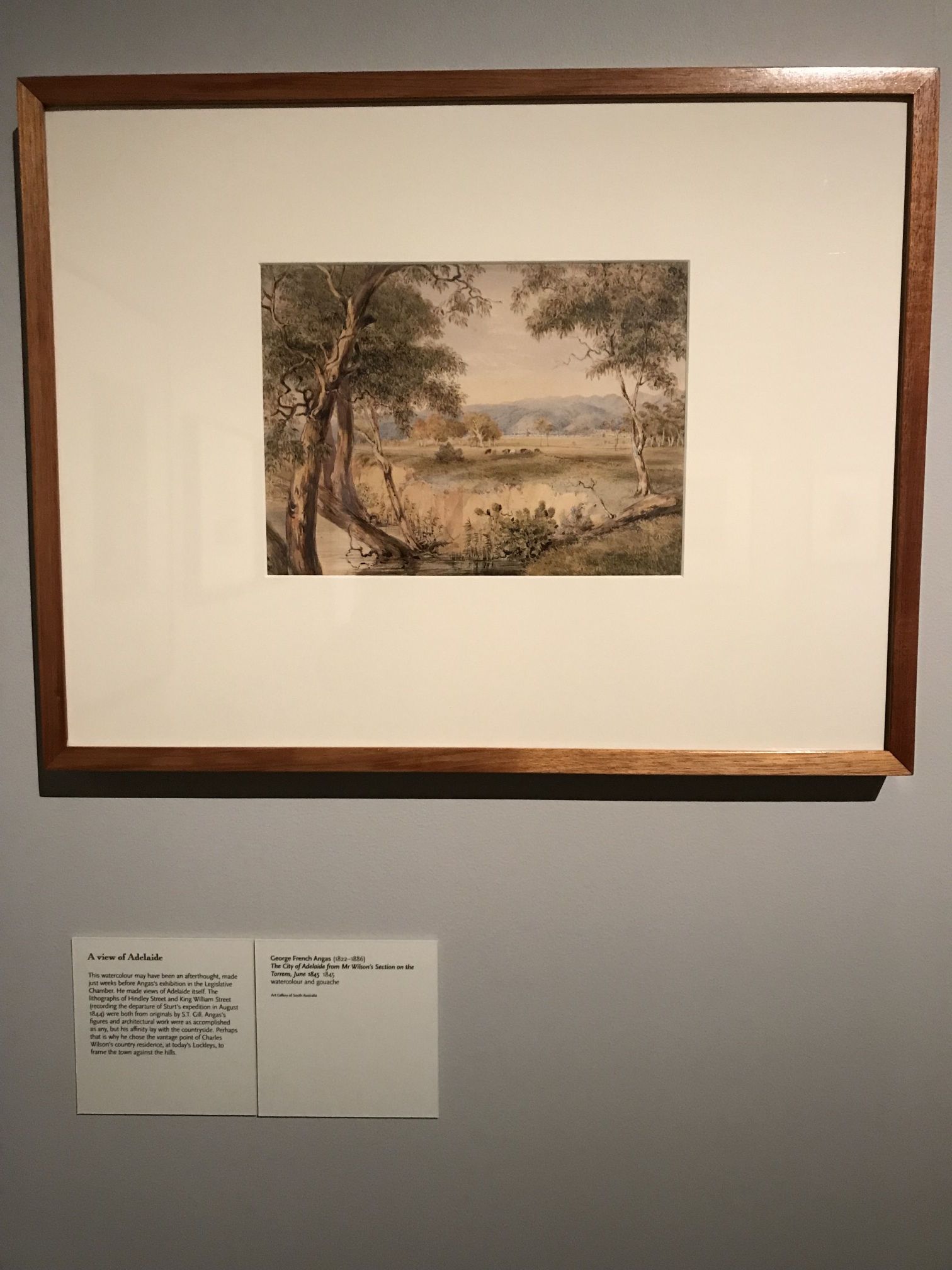
This watercolour was hung in the Egyptian Hall by Angas as his own work. I argue it is by Gill. Here it is on display in NLA, Canberra, November 2021. Author photo. (A detailed analysis is below.)
Turning attention to Angas' London exhibition, it's possible to identify several pictures by S.T. Gill. The catalogue is not illustrated, so there is no certainty in identifying Gill's works, but there can be a good degree of confidence.
Several exhibition titles match a known Gill work but don't correspond with any known Angas.
Angas had brought with him several pictures by Gill. (Reader note: this is not so much additional "proof" as it is the view from the Adelaide end.) Angas had the opportunity for the exhibition to access the Gill works brought to London by E.J. Eyre (and probably Anthony Forster).
Listed below are Gill works probably exhibited by Angas in April 1846, with Angas' catalogue number, catalogue description, collection title and reference and a link to details of the work (which are further down this page):
Following the Egyptian Hall exhibition another source became available to Angas – the large Gill collection brought to England by James Allen. On 13 May, Allen arrived in London with these watercolours and wash drawings. It was too late for Angas to use them in his exhibition, but he did use a few in his two books South Australia Illustrated and Savage Life and Scenes.
After seeing the version of Sturt's Departure that Allen had, Angas decided he too preferred it for its more civilised feel.
There was then still plenty of time for Angas to change his planned contents for South Australia Illustrated. Although the preface is dated 1 July 1846, the large work was in ten parts and delivery was in three stages. Australian advertisements indicate parts 1-3 were shipped from London around December 1846 and the last of the ten parts perhaps mid-1847.3
Before Angas completed his grand work, he apparently borrowed – for they were returned – two Gill paintings from Allen (or from the South Australian Company, of which his father George Fife Angas was chairman). French Angas included them in the latter parts of South Australia Illustrated, attributing them to T.S. Gill.
Angas claimed himself as creator of other pictures by Gill that were made full plates and used Gill works as components in other plates including the cover for each part.
We know Gill was commissioned by the Angases – see J.H. Angas in October 1844 – and it would not surprise if the understanding was that the commissioned works may be published. (Such permission may not have extended to the two "borrowed" "T.S. Gill" works.)
But more than this, it seems Angas had used Gill as a ghost artist. One example is The City of Adelaide from Mr. Wilson's Section on the Torrens, June 1845 (work listed below). Gill may well have agreed to Angas publishing and even taking credit for such works.
After the exhibition was finished and South Australia Illustrated was underway, Angas published two editions of his book Savage Life and Scenes in 1846 and 1847. Although both bear a 1847 date, it was first advertised as available in November 1846.
MR. ANGAS'S ACCOUNT OF THE ANTIPODES. Just published, in 2 vols., post 8vo., with Twelve Plates, from the Author's Drawings, price 24s., handsomely bound in cloth,
SAVAGE LIFE and SCENES in AUSTRALIA and NEW ZEALAND: being an Artist's Impressions of Countries and People at the Antipodes.
By GEORGE FRENCH ANGAS, Esq.
London : Smith, Elder, and Co., 65, Cornhill.5
Gill's Elevated Native Tomb, Myponga Vale, South Australia was reproduced in both editions. Another Gill work, Native Corrobbory, South Australia was only reproduced in the second edition, and such timing suggests this could have been Alex. Murray's corroboree picture sold by him in London in mid-1846.6
A late London effort by Angas was Description of the Barossa Range and its neighbourhood in South Australia published in 1849. The plates are captioned "From Nature and on Stone by G.F. Angas" but Gill probably supplied at least some original work.
On 29 October 1844 John Howard Angas (George French's younger brother) noted in his diary: "out with Mr Gill the artist who has come from town to take some sketches – took Angaston, 'Wheal Sally', sheep washing and flat below Mr Evans".7 These pictures – almost certainly to be watercolours – may have gone to England in December 1844 aboard Symmetry with George Fife Angas' agent Anthony Forster.
The plates in Description of the Barossa Range... are:
For more see:

S.T. Gill at Angas' Barossa 1844
S. T. Gill was in the Barossa sketching for the Angas family from 29 October to 4 November 1844. I identify some works as well as influences on Angas publications: "South Australia Illustrated" and "Barossa Range and its neighbourhood".
Angas, George French. A Catalogue of Paintings by George French Angas, Illustrative of the Natives and Scenery of New Zealand and South Australia : Also Sketches in Brazil, Cape Verde Islands, New South Wales, &c. &c. S.n., 1846. Accessed 24 Dec 2020. <https://search.sl.nsw.gov.au/permalink/f/lg5tom/SLNSW_ALMA21143884040002626>
Angas, George French. Savage life and scenes in Australia and New Zealand : being an artist's impressions of countries and people at the antipodes / by George French Angas Smith, Elder and Co., London, 1st edition, 1847. <https://collection.sl.nsw.gov.au/record/74VvA3vzpqOM>
Angas, George French. Savage life and scenes in Australia and New Zealand : being an artist's impressions of countries and people at the antipodes / by George French Angas Smith, Elder and Co., London, 2nd edition, 1847. <https://collection.sl.nsw.gov.au/record/74Vvgr6DG7E3>
Angas, George French. and Angas, John Howard. Description of the Barossa Range and its neighbourhood in South Australia / by Agricola ; illustrated with maps and coloured plates, from original drawings made on the spot by George French Angas Govt. Pr Adelaide 1979
You can scroll down to see all pictures along with detailed notes or click a link to jump to a specific work from the list.
Gill works for Angas' South Australia Illustrated and the plates.
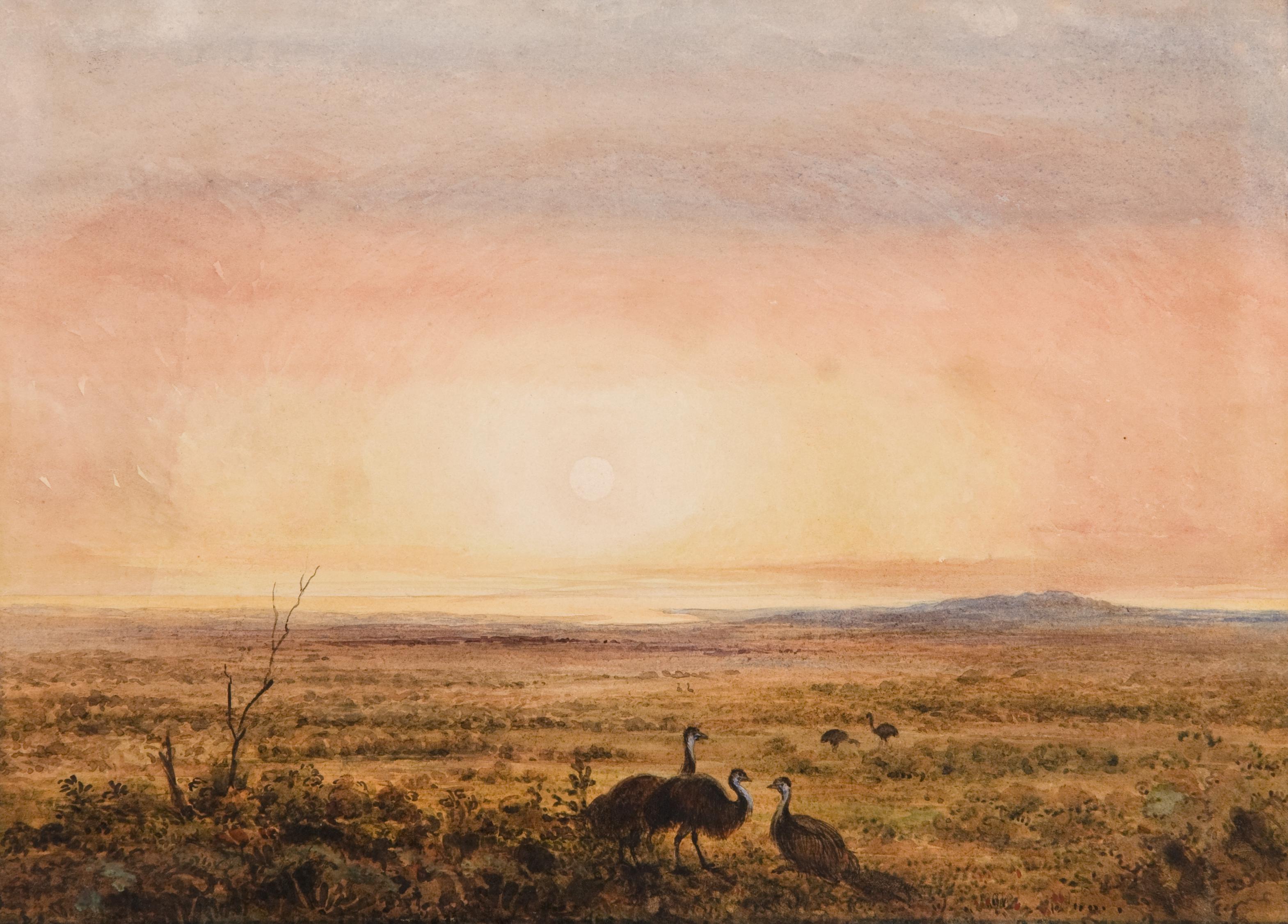 Scene showing emus in a plain (Coorong) | Art Gallery of South Australia 721HP4
Scene showing emus in a plain (Coorong) | Art Gallery of South Australia 721HP4
Artist: Gill, S.T. (attr.) | Date: 1844-06~/1845-06~ | 23(H) x 32.5(W) cm
Catalogue: S.T. Gill and George French Angas, 1844-1845
This scene is not a standalone plate in "South Australia Illustrated" but was used in the composite image on the cover of each section.
A water body appears in the distance, emus in the foreground among low vegetation. The image is quite like Frome's "First view of the salt desert - called Lake Torrens" (AGSA 709HP15) but with emus added. That view is actually Lake Frome (which was known as Lake Torrens at the time).
This work may correspond to Angas' London exhibition no. 186 "Lake Torrens, sunset during a 'sirocco'".
Jones (2021) says this watercolour "[by Angas] appears to be a combination of one of Angas's own watercolours of emus ... with [James] Henderson's mirage-like Lake Torrens shimmering in the distance through a dust storm." (105-107) (I earlier incorrectly stated Jones didn't discuss this work.) The dust storm picture is presently attributed not to Henderson but to E.C. Frome in AGSA catalogue and Auhl & Marfleet, 1977 (89). Jones doesn't explain the Henderson attribution.
The sunset sky is similar to Gill's Horrocks picture, AGSA 0.1253. Foreground detail similar to AGSA 20114P25 (Mount Gambier) suggests Gill, not Angas, as the author of this work (albeit based on another work by Frome).
592
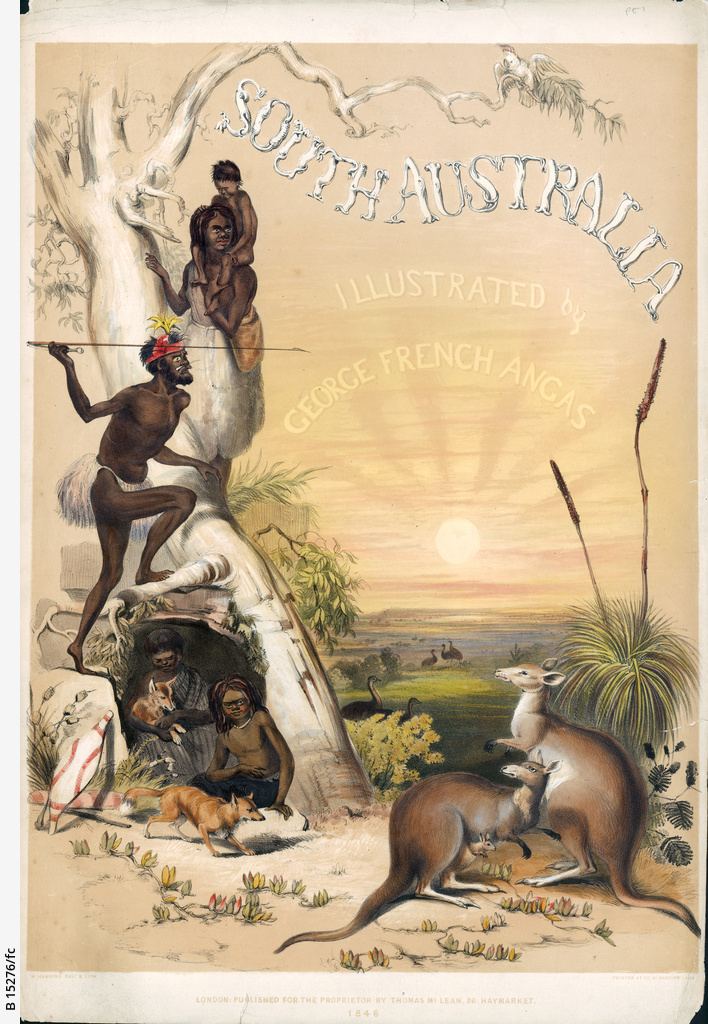 South Australia Illustrated (cover) | State Library of South Australia B 15276/FC
South Australia Illustrated (cover) | State Library of South Australia B 15276/FC
Artist: Angas, G.F. | Date: 1846-07~/1846-12~
Main listing: George French Angas in London and S.T. Gill
Front cover of Angas' "South Australia Illustrated". See also in book context with letterpress: https://digital.collections.slsa.sa.gov.au/nodes/view/2598#idx133367.
The composite image includes the scene of AGSA 721HP4 (probably by Gill after Frome).
599
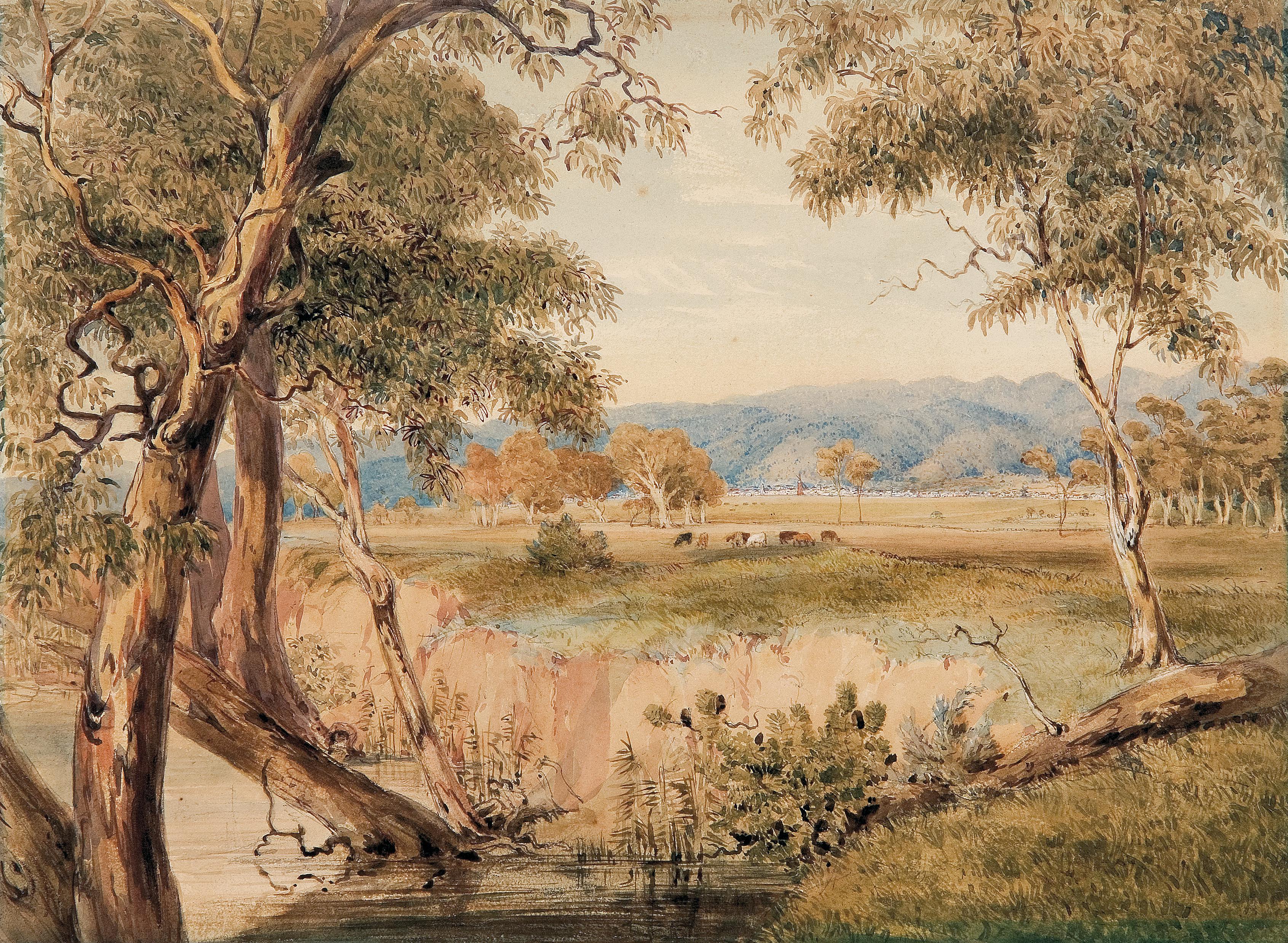 The City of Adelaide from Mr. Wilson's Section on the Torrens, June 1845 | Art Gallery of South Australia 721HP1
The City of Adelaide from Mr. Wilson's Section on the Torrens, June 1845 | Art Gallery of South Australia 721HP1
Artist: Gill, S.T. (attr.) | Date: 1845-06~ | 24.5(H) x 32.8(W) cm
Catalogue: S.T. Gill and George French Angas, 1844-1845
On the reverse in pencil: "City of Adelaide – from Mr Wilson's selection – June 1845" (Tregenza, 1982, 34)
This watercolour is the original for plate 1 in Angas' "South Australia Illustrated" – "The City of Adelaide from the Torrens near the Reed Beds". A picture with this title was also shown in Angas' 1846 Egyptian Hall exhibition (no. 184).
A windmill is just prominent centre (with a reddish coloured tower) and a second one further to the right. These are likely the windmills on the western side of Adelaide (north to south): Phillips' mill (acre 186) corner Waymouth St and West Terrace; and City Mill on Wright Street (acre 464). Phillips' brick mill (readily recognised in other Gill paintings) had its sails disabled by lightning in February 1845 and by April was being fitted as a steam mill.
Through a gap in the trees (middle left) one glimpses buildings on North Terrace – seemingly Trinity Church with its tower, which was so iconically used in portrayals of the city from the northwest (Martha Berkeley, F.R. Nixon). However this detail is omitted from the plate by London lithographer J.W. Giles.
For more detail see the catalogue / main entry.
Map | S. T. Gill - Adelaide District
150
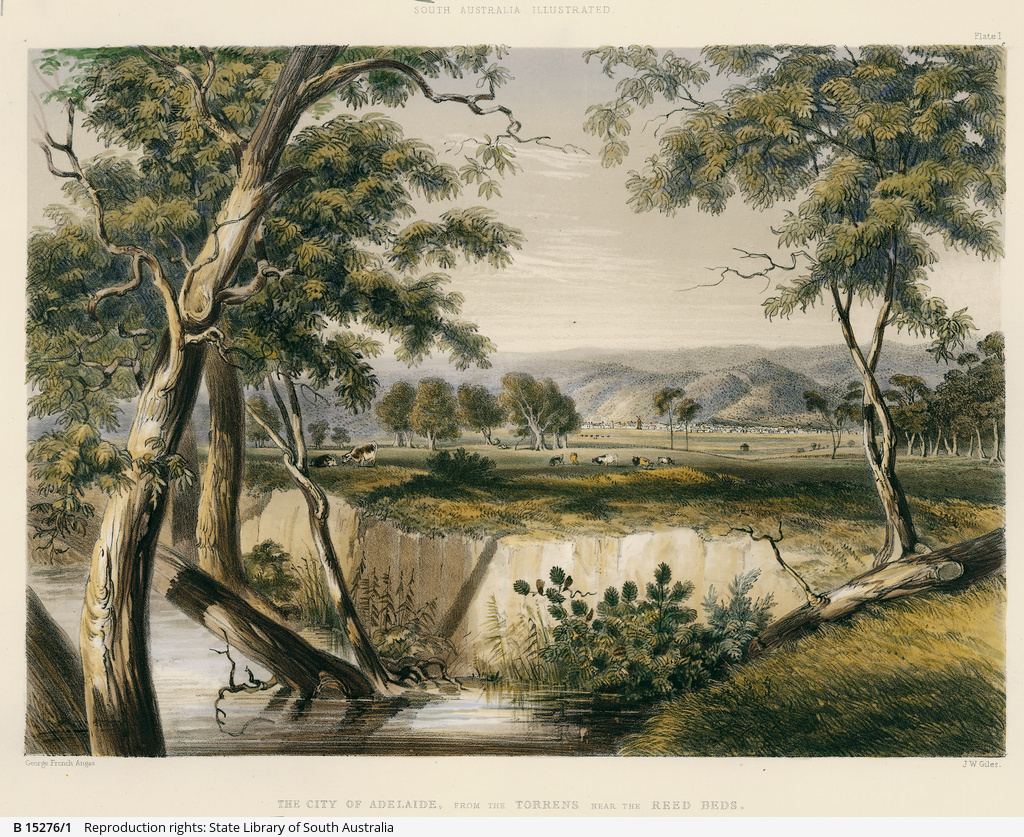 The City of Adelaide, from the Torrens near the Reed Beds | State Library of South Australia B 15276/1
The City of Adelaide, from the Torrens near the Reed Beds | State Library of South Australia B 15276/1
Artist: Gill, S.T. (after) | Date: 1846-07~/1846-12~
Main listing: George French Angas in London and S.T. Gill
Plate 1 in Angas's "South Australia Illustrated". Angas attributes this picture to himself, but it is lithographed from the Gill watercolour AGSA 721HP1.
The watercolour shows buildings on North Terrace between the trees (centre), but this detail is omitted from the plate by London lithographer J.W. Giles.
See also in book context with letterpress: https://digital.collections.slsa.sa.gov.au/nodes/view/2598#idx133375.
535
Port Adelaide, South Australia | National Library of Australia NK208
Artist: Gill, S.T. | Date: 1845-05~/1845-11 | Appleyard cat. n/a | 22.5(H) x 34.2(W) cm
Catalogue: S.T. Gill and James Allen, 1845
A view generally south-east across Gawler Reach / Hindmarsh Reach to Port Adelaide. The Mount Lofty Ranges are in the background. Prominent are the South Australian Company stores (McLaren warehouse, red building, left) and the Customs House (white building, centre). Between them are the flagstaff and the canal beside Queen's Wharf. On the river side of the Customs House are the Queen's wharf warehouses. At right is the confiscated French ship "Ville de Bordeaux". To the left of McLaren warehouse is a shed on McLaren wharf.
This is Gill's more favoured angle across the Reach showing the north and west sides of McLaren warehouse.
This is likely one of James Allen's "Two views of Port Adelaide in 1846". (Allen left Adelaide in November 1845, so "in 1846" is his equivalent of "as it now is".) "Mr Allen then described the port generally, and pointed out the situation of most of its buildings, with the names of their occupants or proprietors. This he afterwards more fully illustrated by two drawings of the port, one taken from its approach by water, and the other from the road leading from the port to town." (The South Australian News (London), July 1846: 50.)
For more detail see the catalogue / main entry.
Map | S. T. Gill - Port Adelaide
222
Port Adelaide, South Australia | National Library of Australia NK4742
Artist: Gill, S.T. (after) | Date: 1846-07~/1846-12~
Main listing: George French Angas in London and S.T. Gill
Plate 7 in Angas's "South Australia Illustrated". Captioned "George French Angas". See also in book context with letterpress: https://digital.collections.slsa.sa.gov.au/nodes/view/2598#idx133392.
Angas attributes this picture to himself, but it is lithographed from the Gill watercolour NLA NK208, which was probably part of James Allen's commission and Angas in London borrowed it from either James Allen or the SA Company.
Map | S. T. Gill - Port Adelaide
223
Klemzig village, South Australia, ca. 1846 | National Library of Australia R6521
Artist: Gill, S.T. (attr.) | Date: 1845-03~/1845-06~ | 17.8(H) x 26.2(W) cm
Catalogue: Klemzig, Angas, a German Hay Wagon and Chickens
A view of the main street of Klemzig. Prominent in the scene are the buildings lining the street on both sides; the Lutheran church with its bell tower at left. Compared with Nixon's print this pencil sketch shifts its viewpoint to the right, omits a house at near left and adds half a house at right.
This pencil sketch is in George French Angas' "Sketchbook no. 3". Pencil caption (l.r.) appears to read "Klemzig village". It is the same scene as plate 12 "Klemzic. A Village of German settlers near Adelaide" in Angas's "South Australia Illustrated". It is also the same view as, albeit with less content than, F R Nixon's print "Klemzig (German Village on the Torrens)" (February 1845).
In the middle foreground is a very lightly pencilled German hay wagon which appears the same in Angas' print but slightly different in Nixon's. The woman looking to the viewer at right is similar in the sketch and Angas' print. There are also two empty hay wagons further down the street. Other detail is the same too. Four fowl peck the ground.
This sketch is very likely the preliminary sketch for the watercolour AGSA 721HP6 in which the hay wagon has been fully realised and the goat inserted from Angas's figure studies.
I conclude this pencil sketch is likely by Gill for Angas.
Map | S. T. Gill - Adelaide District
509
Klemzic, a village of German settlers | National Library of Australia NK4742
Artist: Angas, G.F. (after) | Date: 1846-07~/1846-12~
Plate 12 in Angas's "South Australia Illustrated". See also in book context with letterpress: https://digital.collections.slsa.sa.gov.au/nodes/view/2598#idx133402.
A view of the main street of Klemzig. Prominent in the scene are the buildings lining the street on both sides; the Lutheran church with its bell tower at left; and a German hay wagon in the foreground.
Angas attributes this picture to himself. It was likely lithographed from a watercolour (AGSA 721HP6) which in turn was derived from a pencil sketch (NLA R6521).
"Klemzig" and "Bethany" are the only images in "South Australia Illustrated" showing chickens and a rooster.
Angas refers to Klemsic in his "Savage Life & Scenes" (1, 212).
Further examples of plate 60 in other collections:
* SLSA B 15276/12 https://collections.slsa.sa.gov.au/resource/B+15276/12
533
 Blue Lake, Mount Gambier | Art Gallery of South Australia 20114P25
Blue Lake, Mount Gambier | Art Gallery of South Australia 20114P25
Artist: Gill, S.T. (attr.) | Date: 1844-06~/1845-06~ | 24.7(H) x 34(W) cm
Catalogue: S.T. Gill and George French Angas, 1844-1845
The scene is Mount Gambier and one of its volcanic lakes. The lake walls seem more steeply sloped than in the wash drawing. Birds fly across the lake and sit in a (sheoak?) tree. Rising smoke to the left of Mount Gambier likely suggests the presence of Aboriginal people.
George French Angas accompanied Governor Grey's expedition to S.E. South Australia in April-May 1844 and the party explored this place on 6 May 1844 noting the "numerous ducks" on the lake.
This watercolour was the basis for plate 17 of Angas' "South Australia Illustrated": "Mount Gambier, with one of its volcanic lakes (after sunset)". This work may be that in Angas' London exhibition no. 181 "Mount Gambier and one of its volcanic lakes".
This work is very similar to Gill's 1844/1845 wash drawing (NLA NK7073/6) but differs in a grander scale for the lake and larger and more numerous waterbirds. Note the similar three trees on the lake wall (left middle). The most straightforward explanation would be that this grander watercolour was developed from Gill's humbler picture (and not the other way round).
This watercolour is likely by Gill. The foreground vegetation detail is consistent with Gill's style. The sunset sky is also similar to Gill's Horrocks picture, AGSA 0.1253. It was most likely painted around May-June 1845 when Angas was in Adelaide finalising material for "South Australia Illustrated".
Just like NLA NK7073/6 this picture is probably intended to represent Blue Lake with its steep walls, but it is not topographically correct, and the view seems foreshortened (eliminating Valley Lake) for effect.
For more detail see the catalogue / main entry.
Map | S. T. Gill - South Australia
487
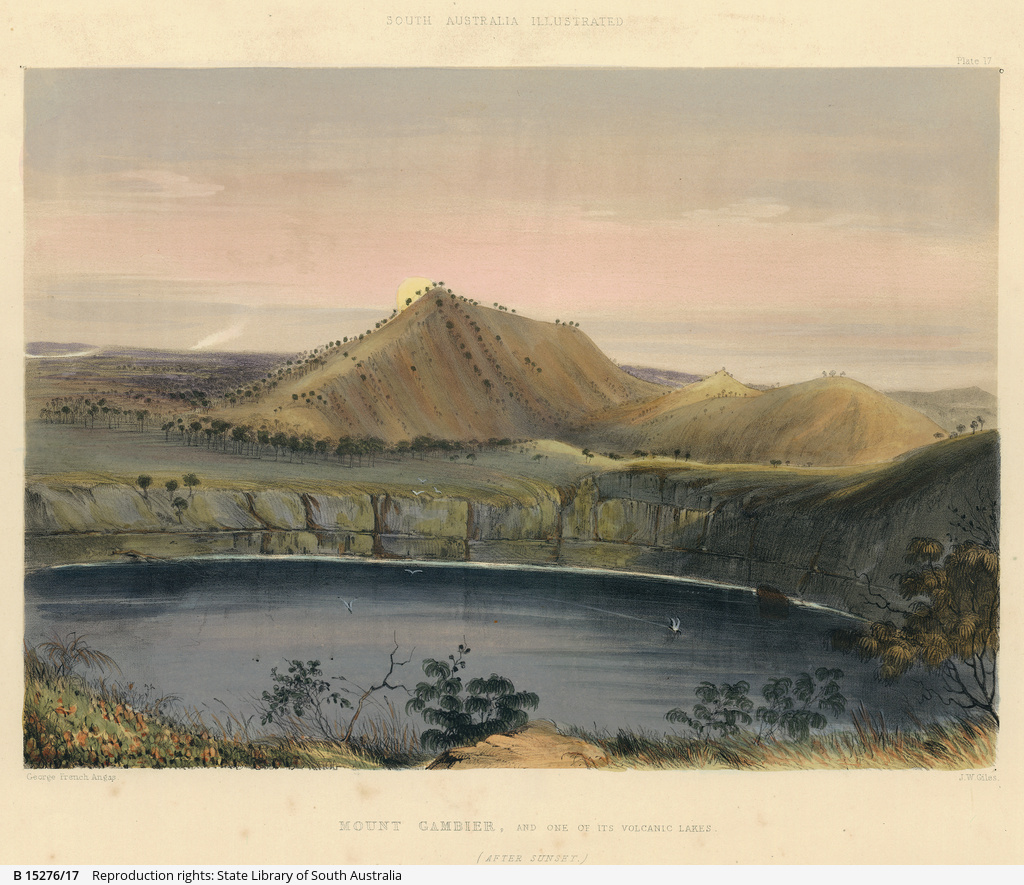 Mount Gambier, with one of its volcanic lakes (after sunset) | State Library of South Australia B 15276/17
Mount Gambier, with one of its volcanic lakes (after sunset) | State Library of South Australia B 15276/17
Artist: Gill, S.T. (after) | Date: 1846-07~/1846-12~
Main listing: George French Angas in London and S.T. Gill
Plate 17 in Angas's "South Australia Illustrated". Based on the watercolour AGSA 20114P25. See also in book context with letterpress: https://digital.collections.slsa.sa.gov.au/nodes/view/2598#idx133415.
Angas describes the location and view: "... the extinct Craters of Mount Gambier, containing several volcanic lakes, enclosed within abrupt walls of lava. The hollows or craters are three in number, that, at the western extremity being the most extensive; the interior of the latter presents scenery of the most novel and romantic description ... The third and easternmost [crater], is entirely occupied by a lake of unknown depth, that looks fearfully dark and gloomy when viewed from the heights above; the accompanying sketch is taken looking across this last mentioned lake, towards the principal crater; the effect represented is one truly Australian, when the moon rises at its full in the roseate sky left by the reflection of the departed sun."
Angas's poetic description, when combined with this being a view to the west, seems to suggest the bright orb behind Mount Gambier is a rising moon, when in actuality it would be a setting sun.
486
Kangaroo coursing | National Library of Australia NK7063/15
Artist: Gill, S.T. | Date: 1844~/1845~ | Appleyard cat. n/a | 13.6(H) x 20.6(W) cm
Catalogue: S.T. Gill and John Napier Magill
The scene is of kangaroo coursing with two mounted riders and three hounds chasing two kangaroos through the bush. Gill's kangaroos were not a strong point and their motion here looks unrealistic.
"The kangaroo is the largest quadruped found in the country. This singular animal has already been so often described, that is that it is unnecessary here to give a particular account of it. Kangaroos are found in great numbers in most of the districts of South Australia; although they gradually seem to retire into the interior as civilisation advances. A kind of hound, something like the Scotch stag-hound, is common in the country, for hunting them. The kangaroo is very shy, and it is seldom the hunter can get one within rifle range. Most of them are therefore taken with the hounds." Bennett (1843) 44-45.
This wash is a predecessor to an almost identical one for James Allen (NLA R117).
This scene was incorporated in plate 19, "Kangaroo Hunting, near Port Lincoln. Albert Park in the distance" of George French Angas's "South Australia Illustrated".
For more detail see the catalogue / main entry.
101
Hunting the kangaroo | National Library of Australia R117
Artist: Gill, S.T. | Date: 1845-05~/1845-11 | Appleyard cat. n/a | 11.7(H) x 19.7(W) cm
Catalogue: S.T. Gill and James Allen, 1845
The scene is of kangaroo coursing with two mounted riders and three hounds chasing three kangaroos through the bush. Gill's kangaroos were not a strong point and their motion here looks unrealistic. This is one of only two pictures in James Allen's wash collection with an unspecified location.
For more detail see the catalogue / main entry.
11
Port Lincoln, South Australia | National Library of Australia R6411
Artist: Angas, G.F. | Date: 1844/1846~ | 19.1(H) x 34(W) cm
Main listing: George French Angas in London and S.T. Gill
Sketch of the landscape which was the basis for plate 19 in Angas's "South Australia Illustrated" (and its corresponding watercolour). It does not include the action of the colonists hunting kangaroo.
Sketched 7 May 1845. Angas returned to Adelaide from Port Lincoln on 13 May 1845.
Reverse inscription: Albert Peak - Port Lincoln - So Aust. / Emus & kangaroos / May 7th 1845
579
 Kangaroo hunting, Eyre Peninsula | Art Gallery of South Australia 20114P26
Kangaroo hunting, Eyre Peninsula | Art Gallery of South Australia 20114P26
Artist: Gill, S.T. (attr.) | Date: 1845-05~/1846~ | 23.4(H) x 32.4(W) cm
Catalogue: S.T. Gill and George French Angas, 1844-1845
This work corresponds with Angas' London exhibition no. 202 "Kangaroo Hunting, country westward of Port Lincoln, with Albert's Peak in distance". This is also the watercolour for plate 19 in Angas's "South Australia Illustrated".
It appears based on a Port Lincoln landscape sketch NLA R6411 dated 7 May 1845.
This unsigned watercolour incorporates action in Gill's wash drawings such as NLA NK7063/15 or NLA R117 (for James Allen). The kangaroos here look just as unrealistic as those in the wash drawings and the number and positiion of riders, dogs and kangaroos are almost identical.
This would suggest one of three possibilities - that this watercolour may have been painted:
1. by Angas in London after Angas borrowed Gill's "Hunting the Kangaroo" (NLA R117) from Allen or the SA Company – around mid-1846;
2. by Angas in South Australia (using Gill's action figures); or
3. by Gill for Angas before he left South Australia in July 1845.
If painted in South Australia it was likely painted around May-June 1845 after Angas returned from Port Lincoln.
This may be one of the pictures Angas was selling in Melbourne in April 1851. [Provenance: Douglas and Barbara Mullins 2011.]
I think it is more likely by Gill than Angas.
546
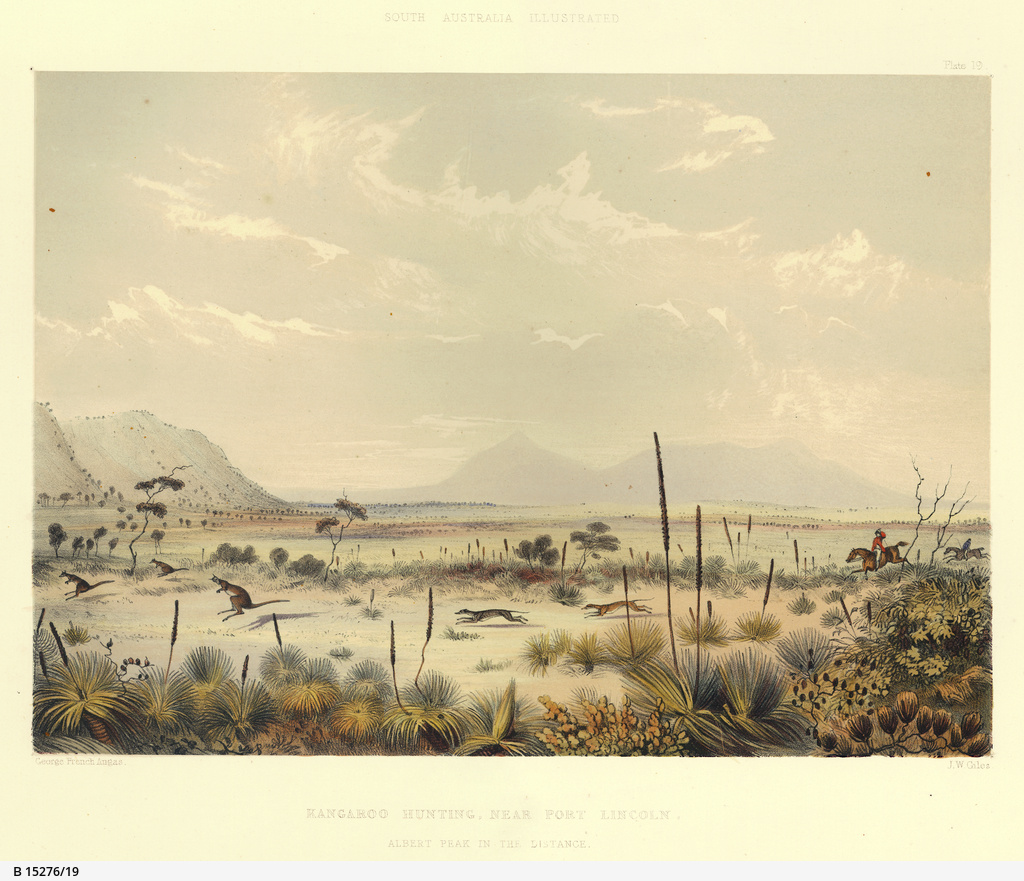 Kangaroo hunting in the scrub | State Library of South Australia B 15276/19
Kangaroo hunting in the scrub | State Library of South Australia B 15276/19
Artist: Gill, S.T. (after) | Date: 1847-01~/1847-06~
Main listing: George French Angas in London and S.T. Gill
Plate 19 in Angas's "South Australia Illustrated". See also in book context with letterpress: https://digital.collections.slsa.sa.gov.au/nodes/view/2598#idx133419.
Angas attributes it to himself. It incorporates action from NLA NK7063/15 or Gill's wash drawing for James Allen (NLA R117).
534
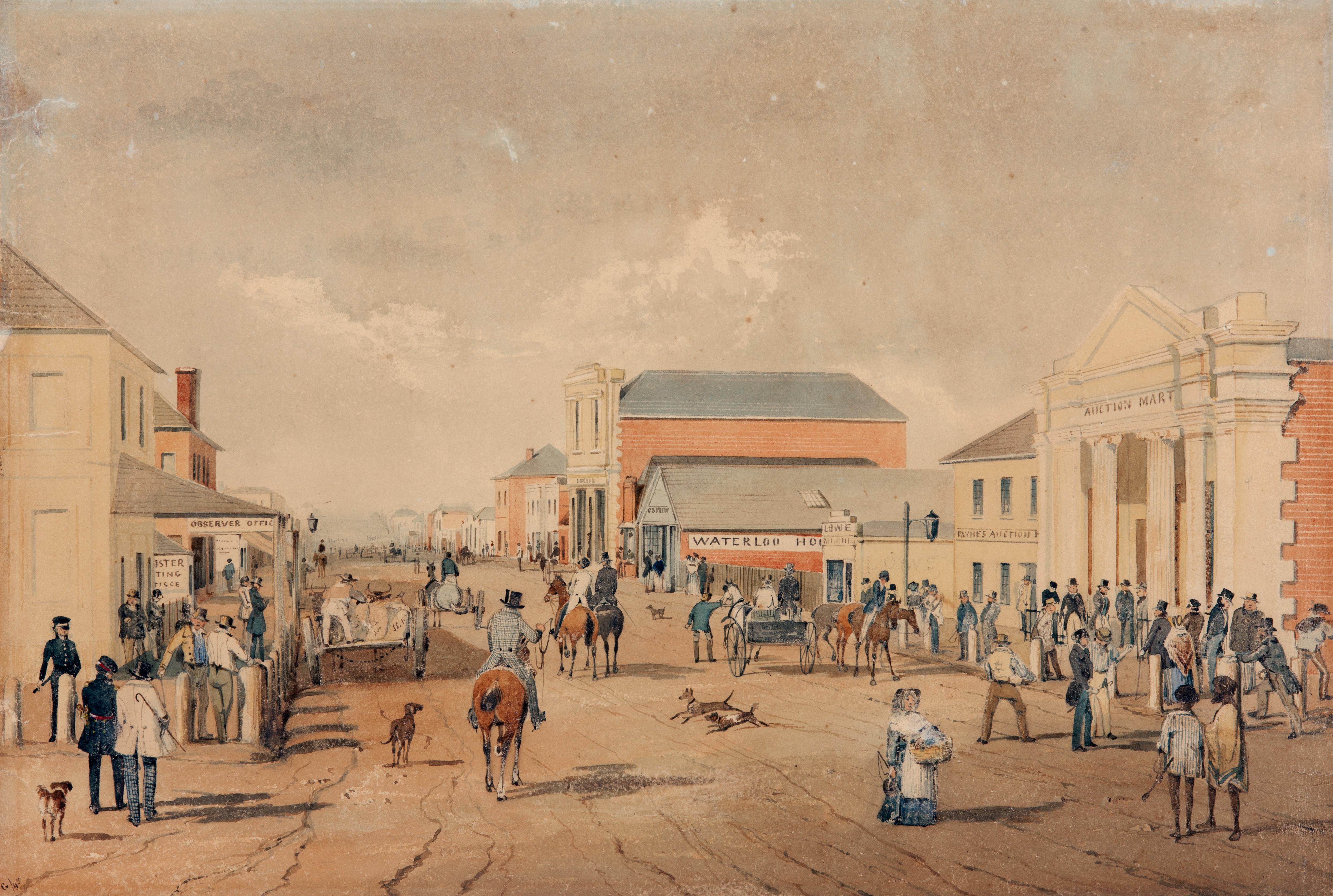 Hindley Street, Adelaide, looking west from King William Street | Art Gallery of South Australia 0.642
Hindley Street, Adelaide, looking west from King William Street | Art Gallery of South Australia 0.642
Artist: Gill, S.T. | Date: 1845-10~/1845-11 | Appleyard cat. 44 | 27.3(H) x 39.8(W) cm
Catalogue: S.T. Gill and James Allen, 1845
This is a view to the west along Hindley Street from its intersection with King William Street.
Building signs on the left (south) side leading away from the viewer are: Register Printing Office (... ister ... ting ... ficce) and Observer Office. On the right (north) side are: Auction Mart, Payne's Auction (Mart Tavern), Lowe (chemist), Waterloo House and C. S. Platts, with the next sign (illegible) being the two storey whitestone fronted brick building of Robert Sanders, draper. Platts was at Waterloo House (acre 48) to April 1844 after which the building was occupied by John Stephens who also moved his Observer newspaper office there. The building at near left was a store formerly occupied by Murray and Greig and also Stocks. After buying James Allen's SA Register, John Stephens consolidated the Register and Observer and General Printing Office in this building from 20 September 1845. The Auction Mart at right is at it appeared after the whitestone front was added in December 1844 and before the eastern collonade was added in December 1845. We can thus date this scene around October / November 1845.
The name "C.S. Platts" on Waterloo House is likely an anachronistic nod to the manner in which Stephens supplanted Platts' business in which he allowed the Platts name to be associated with his identical business.
The parked bullock dray at left of picture contains sacks with unclear labels, seemingly reading SG, STG 200 and SG 1. This seems to be a reference to James Allen's commission - see also AGSA 0.647. This picture is part of the James Allen commission. I think the character at left in the checked jacket, appearing in several pictures of the Allen commission, is likely James Allen. The Aboriginal man right foreground is draped in a government issue blue striped blanket.
For more detail see the catalogue / main entry.
Map | S. T. Gill - Adelaide
16
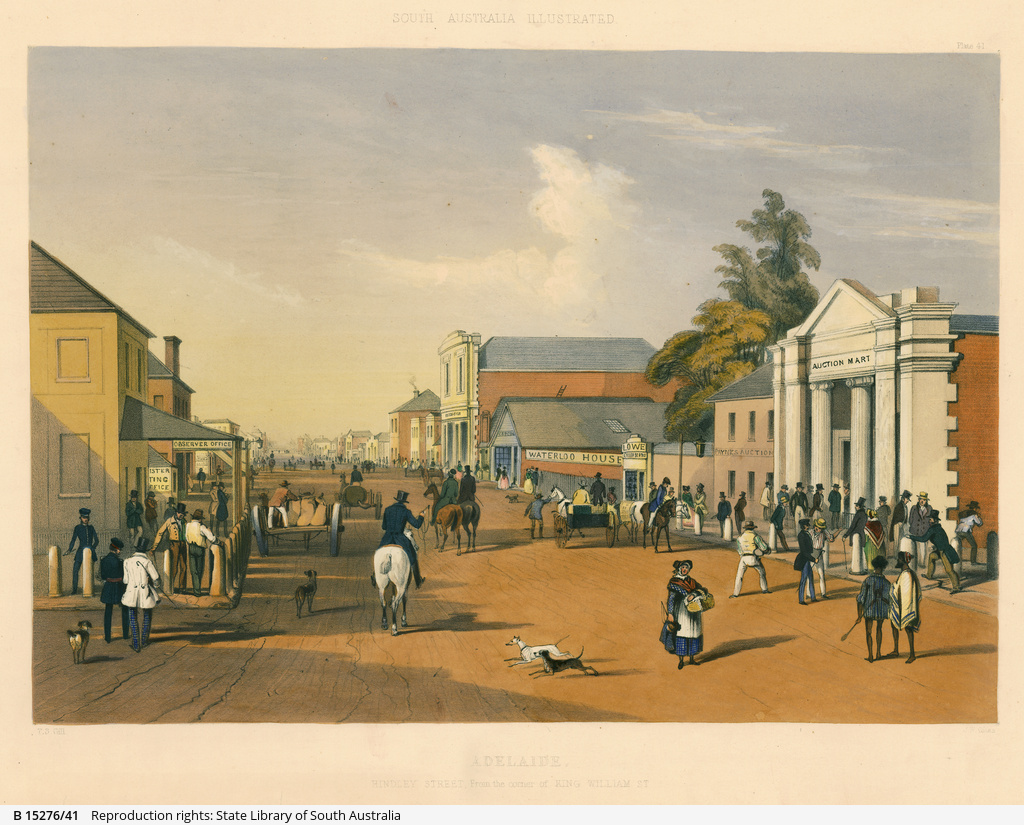 Adelaide. Hindley Street from the corner of King William Street | State Library of South Australia B 15276/41
Adelaide. Hindley Street from the corner of King William Street | State Library of South Australia B 15276/41
Artist: Gill, S.T. (after) | Date: 1847-01~/1847-06~
Catalogue: George French Angas in London and S.T. Gill
Plate 41 in Angas's "South Australia Illustrated". See also in book context with letterpress: https://digital.collections.slsa.sa.gov.au/nodes/view/2598#idx133480.
Angas attributes this picture to T.S. Gill. The original Gill watercolour (AGSA 0.642) was in the South Australian Company collection (No.4) and was from James Allen's commission. The conclusion is that Angas in London borrowed the original from either James Allen or the SA Company.
474
[Group of Aborigines on an island with two Europeans on shore] | Dixson Library, State Library of New South Wales DGA 58 f.65
Artist: Gill, S.T. | Date: 1845~/1847~ | Appleyard cat. n/a
Main listing: George French Angas in London and S.T. Gill
A group of Aborginal people are fishing by diving into the water from what appears to be a raft. Two European men watch from the shore. The same view, without the Europeans, appears as a small vignette in plate 51 of Angas's "South Australia Illustrated". There it is described as "19. Native women on a raft, fishing for mussels (Karkirra). Lake Alexandrina." Also on that plate is another scene portrayed by Gill of Aboriginal women fishing for crayfish.
The main subject could be a raft made of reeds by the Ngarrindjeri people (see SLSA B 29488 <https://collections.slsa.sa.gov.au/resource/B+29488>).
The scene is very similar in composition to Cawthorne's SLNSW-M PXD 39 f.04 <https://collection.sl.nsw.gov.au/record/YoldAjG9/OlGlRObKPEMAM> showing two European men watching Aboriginal people fishing from canoes.
This watercolour is in the album of EW Belcher who was a student of WA Cawthorne who in turn was a student of Gill. Previously atrributed to Cawthorne.
463
River Murray woman fishing for crawfish - from sketch of Mr G. Hamilton | Mitchell Library, State Library of New South Wales PX*D 73 f.6
Artist: Gill, S.T. | Date: 1844-11~ | Appleyard cat. n/a
Catalogue: S.T. Gill, E.J. Eyre, Symmetry 1844
Aboriginal women work together in line to catch crayfish (eukodko/ukodko) in the flood waters of the Murray River. The river flats have been inundated, as have the colonists' post and rail fence. The foreground reclining figure appears to be the luxuriating indolent male of Eyre's description.
In another version of the same scene (NLA NK2041), Gill notes it is "from Mr Hamilton's sketch". So this too is based on an (unknown) original sketch by George Hamilton.
This watercolour is positively identified as being for E.J. Eyre, having a reverse inscription: "– Eyre Esqr –".
This subject is treated in Eyre's book. "At Moorunde, when the Murray annually inundates the flats, fresh-water cray-fish make their way to the surface of the ground from holes where they have been buried during the year, in such vast numbers that I have seen four hundred natives live upon them for weeks together, whilst the numbers spoiled or thrown away would have sustained four hundred more. This fish is an excellent and nutritious article of food, and would be highly prized by the epicure. It is caught by the women who wade into the water in a long close line, stooping down and walking backwards, whilst they grope with their hands and feet, presenting a singular, and to the uninitiated, an incomprehensible spectacle, as they move slowly backwards, but keep the line regular and well preserved, as all generally occupy the same position at one time. When a cray-fish is caught the large claws are torn off to prevent the animal from biting, and both claws and body are put into a small net suspended from the neck for that purpose. In two or three hours a woman will procure as many fish as will last her family for a day. The men are too lazy to do anything when food is so abundant, and lie basking under the trees in luxurious indolence, whilst their wives, mothers, or sisters are engaged in cooking for them." Eyre, Vol. 2, 252-3.
George French Angas' 1846 London exhibition included a work of a similar description: No. 159.21 "Women on back waters of Murray fishing for cray-fish". The scene also appears as a small vignette in plate 51 of Angas's "South Australia Illustrated".
45
The Aboriginal Inhabitants: Implements and Utensils | State Library of South Australia B 15276/51
Artist: Angas, G.F. | Date: 1847-01~/1847-06~
Main listing: George French Angas in London and S.T. Gill
Plate 51 of Angas' "South Australia Illustrated". See also in book context with letterpress: https://digital.collections.slsa.sa.gov.au/nodes/view/2598#idx133508.
Title from plate caption below. Title of the accompanying text: "The Aboriginal Inhabitants: Native Implements and Domestic Economy".
Two of the central vignettes are scenes also painted by S.T. Gill:
19. Native women on a raft, fishing for mussels (Karkirra). Lake Alexandrina.
21. Women fishing for crayfish, in the back waters of the Murray, after the periodical floods.
581
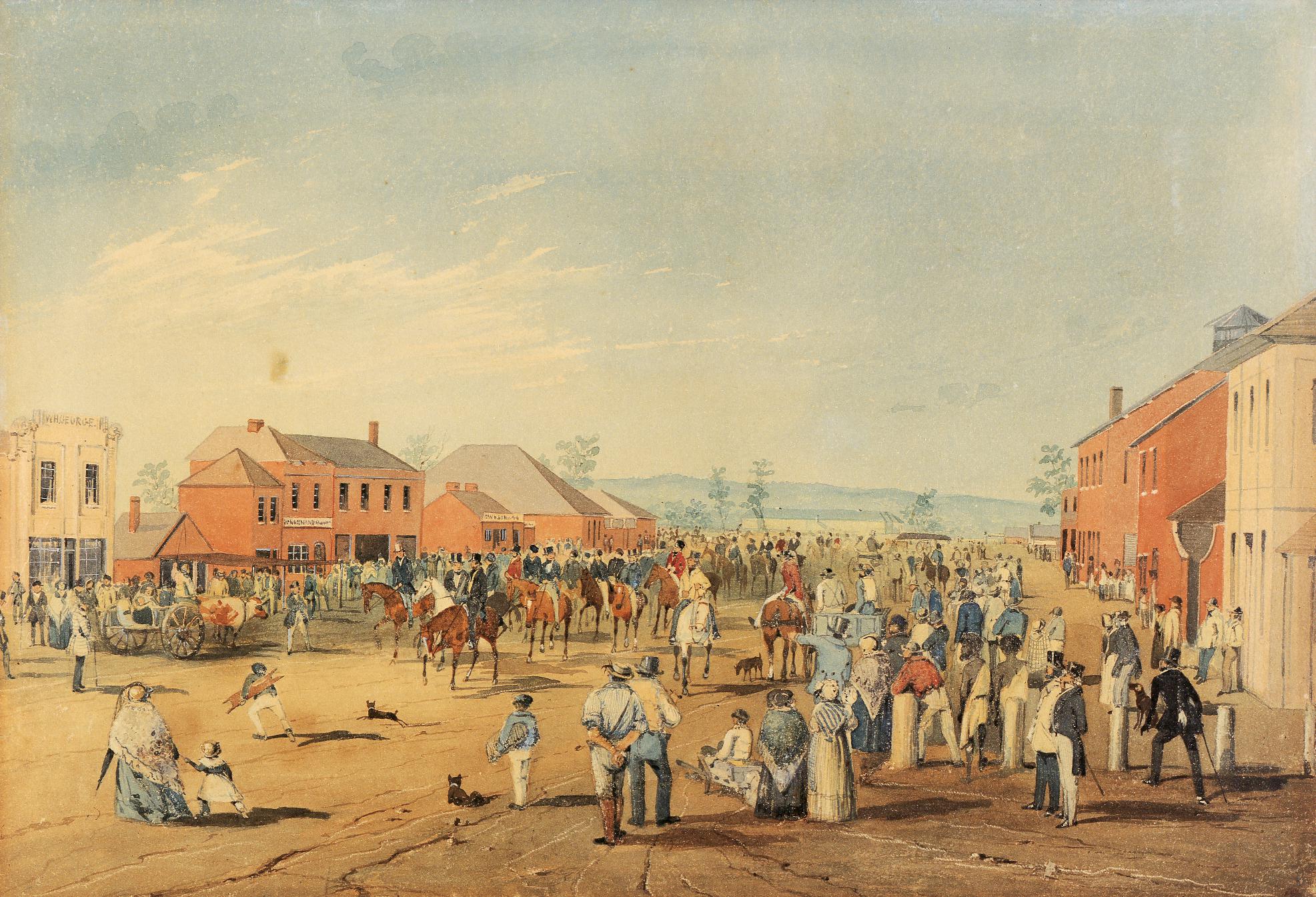 Sturt's Overland Expedition leaving Adelaide, August 10th, 1844 | Art Gallery of South Australia 0.644
Sturt's Overland Expedition leaving Adelaide, August 10th, 1844 | Art Gallery of South Australia 0.644
Artist: Gill, S.T. | Date: 1845-06~/1845-11 | Appleyard cat. 81 | 27.2(H) x 40(W) cm
Catalogue: S.T. Gill and James Allen, 1845
The scene is the departure from Adelaide of Charles Sturt's Great Northern Expedition on 10 August 1844 ("head-on" view).
Charles Sturt and other dignitaries are at the head of the procession, with Sturt wearing top hat and tails and riding his well-known grey horse. The newspaper reported Major O'Halloran, Captain Sturt and Judge Cooper led. The view is south along King William Street from the intersection with Hindley Street (right foreground) and Rundle Street (out of picture) and includes street frontages in Adelaide acres 78 (right) and 79 and 108 (left).
The large red double storey building (signed, fourth from left) belonged to dentist surgeon Robert Norman and was built between April and July 1845. Also a building (right) shows William Younghusband's stores with its octagonal turret (completed around March 1845). Both buildings are anachronisms for Sturt's departure. So this was not Gill painting "on the spot" in August 1844.
Other buildings are from left: W.H. George plumber and glazier (white stone front), possibly C. Hussey, Robert Norman surgeon dentist, vacant land, Day and Sons blacksmiths, Montefiore merchant. Buildings at right likely include W. Richards tailor (opposite W.H. George).
This painting was used by George French Angas for plate 54 in his "South Australia Illustrated" and attributed to T.S. Gill. Although the painting could have been painted just in time for Angas' departure from Adelaide on 2 July 1845, there is strong provenance and other evidence for this being part of James Allen's commission. Allen left Adelaide for England in November 1845 and the painting was probably executed between July and November 1845. This implies Angas borrowed it from Allen or the South Australian Company when preparing the final installment of "South Australia Illustrated".
This picture is part of the James Allen commission. I think the character at left in the checked jacket, appearing in several pictures of the Allen commission, is likely James Allen.
For more detail see the catalogue / main entry.
Map | S. T. Gill - Adelaide
248
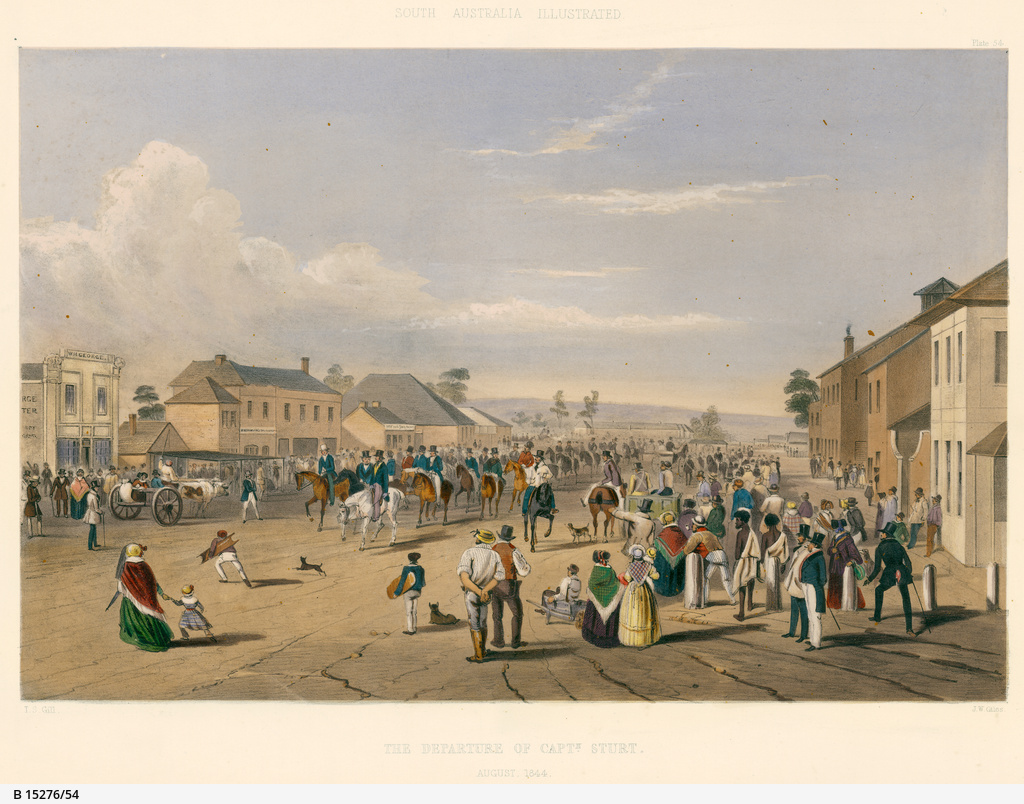 The departure of Captain Sturt on his expedition into the interior | State Library of South Australia B 15276/54
The departure of Captain Sturt on his expedition into the interior | State Library of South Australia B 15276/54
Artist: Gill, S.T. (after) | Date: 1847-01~/1847-06~ | Appleyard cat. 81.1
Catalogue: George French Angas in London and S.T. Gill
The scene is the departure from Adelaide of Charles Sturt's Great Northern Expedition on 10 August 1844 ("head-on" view).
It is Plate 54 in Angas's "South Australia Illustrated". See also in book context with letterpress: https://digital.collections.slsa.sa.gov.au/nodes/view/2598#idx133515.
Angas attributes this picture to T.S. Gill. The original Gill watercolour (AGSA 0.644) was in the South Australian Company collection (No.10) and was from James Allen's commission. The conclusion is that Angas in London borrowed the original from either James Allen or the SA Company.
249
Gill works, known and untraced, for Angas' Savage Life and Scenes.
Natives crouching [i.e. stalking] emus | Mitchell Library, State Library of New South Wales PX*D 73 f.7
Artist: Gill, S.T. | Date: 1844-11~ | Appleyard cat. n/a
Catalogue: S.T. Gill, E.J. Eyre, Symmetry 1844
Two Aboriginal men, with spears and spear-throwers, disguise themselves with branches as they stalk a pair of emu.
This watercolour is positively identified as being for E.J. Eyre, having a reverse inscription: "– Eyre Esqr –".
This subject is treated in Eyre's book. "A native travelling with his family through the woods, when he sees a kangaroo feeding or sleeping, will steal silently and cautiously upon it, keeping, as he advances, a tree or shrub between himself and the animal, or holding up before him, if he be in an open place, a large branch of a tree, until sufficiently near to throw the fatal weapon ... The emu is taken similarly to the kangaroo." Eyre, Vol. 2, 276-8.
George French Angas' June 1845 Adelaide exhibited included a work titled "Tattaayra (sic.) sneaking the Emu". South Australian Register, 21 June 1845: 2. <http://nla.gov.au/nla.news-article73842625>. Angas' 1846 London exhibition also included a work of a similar description: No. 208 "Tattayarra Natives sneaking Emus, in the country beyond the Murray". A similar (but cropped) image was used by Angas as the title page sketch of his book "Savage Life and Scenes" (September 1846).
46
Tattayarra sneaking emu - Australia | State Library of New South Wales DSM/980/205A1
Artist: | Date: 1846
Main listing: George French Angas in London and S.T. Gill
This vignette appeared on the title page of Angas' book "Savage Life and Scenes" (vol. 1, preface dated September 1846).
It may be an interpretation of Gill's "Natives crouching emu" painted for Eyre and taken by him to England. Although Angas' "South Australia Illustrated" included his portrait of a Tatiara man (Plate 18), he had no scenes of emu hunting either there or in his relevant sketch book.
Angas' June 1845 Adelaide exhibition included (reportedly) "'Tattaayra,' sneaking the Emu" and his London exhibition included "Tattayarra Natives sneaking Emus, in the country beyond the Murray".
I've found no evidence that either Angas or Gill sketched such a scene "on the spot". The image seems to have originated with E.J. Eyre.
447
 Native tomb, Myponga | South Australian Museum AA8/4/1
Native tomb, Myponga | South Australian Museum AA8/4/1
Artist: Gill, S.T. | Date: 1844-05~ | Appleyard cat. 39 | 18.5(H) x 28.5(W) cm
Catalogue: S.T. Gill and George French Angas, 1844-1845
The scene is an Aboriginal elevated mortuary platform near a stream, with birds descending and a pair of dingoes below. Sparsely treed hills are in the background. Grass tree and honeysuckle are represented.
I shall refer to this as the Angas/SA Museum picture. Gill painted two almost identical watercolours of this scene, the other being the Eyre/RCS picture for E.J. Eyre. One would think they were likely executed within days of each other, likely in May 1844.
George French Angas reproduced this as plate 2 in his "Savage Life and Scenes", published in November 1846. George French Angas' 1846 London exhibition included a work of a similar description: No. 209 "Elevated Native Tomb at Myponga" which is likely this work.
For more detail see the catalogue / main entry.
207
Elevated Native Tomb, Myponga Vale, South Australia [plate] | State Library of New South Wales DSM/980/205A1
Artist: Gill, S.T. (after) | Date: 1846 | Appleyard cat. 39.1
Catalogue: George French Angas in London and S.T. Gill
Plate in George French Angas' book "Savage Life and Scenes" (vol. 1, 71) and captioned "George French Angas del". Despite this claim to authorship by Angas, the plate is based precisely on Gill's watercolour (SAM AA8/4/1). (It was plate 2 in the first edition and plate 7 in the second. Links here are to the first edition.)
The text adjacent to the plate reads: "Several elevated native burying-places may be seen along the margin of the Lake Alexandrina. The wind makes dirge-like music amongst the reeds where these tombs stand, and blows chill across the dark and dreary lake; conveying a perfect idea of solitude and desolation and death. The accompanying plate represents an elevated tomb at Myponga; in connection with which I have been favoured with the following beautiful passage from the pen of my friend Mr. Miles of Sydney ... [a poem follows]". (p. 71) The same verse accompanied "209. Elevated Native Tomb at Myponga" in Angas' London Exhibition.
The leap in Angas' text from Lake Alexandrina to Myponga (and then back to the Murray River) illustrates Angas's lack of geographical flow in the narrative. Angas further writes about mortuary platforms where the Murray River flows into Lake Alexandrina (p.60) and at the Coorong (p.86). Angas made his own sketches of mortuary platforms around Lake Alexandrina and the Coorong – see "South Australia Illustrated", plate 40, "The Aboriginal Inhabitants. Native Tombs", so it would seem he selected this portrayal by Gill specifically for its evocative atmosphere and to complement his poetic inclinations.
Tregenza noted Angas' plate is derivative of an undoubted Gill painting. "The lithograph 'Elevated Native Tomb, Myponga Vale, South Australia' printed on p. 70 in the first volume of Savage Life and Scenes is definitely based, down to the last detail, on a fine watercolour by S.T. Gill of similar title now in the South Australian Museum (acc. no 1484)." (Tregenza, 17)
345
Native Corrobbory, South Australia | State Library of New South Wales DSM/980/205B1/v. 1
Artist: Gill, S.T. (after) | Date: 1846
Catalogue: George French Angas in London and S.T. Gill
Plate in George French Angas' book "Savage Life and Scenes" (2nd edition, 1847, vol. 1, frontispiece). (This plate was not in the 1st edition.)
The scene is an Aboriginal corroboree around a fire on a full moon; sparsely treed hills in the background; men dance with spears; spectators seated at left provide accompaniment.
Angas claims authorship with the caption "George French Angas, del". However I find no original Angas sketch corresponding to this scene.
The style is not like Angas and the figures are not like those in Angas' own work, such as "Kuri Dance" SAM AA8/2/5/1. Instead this picture is much like Gill's and the composition is very similar to most of his corroboree pictures, e.g. the 1849 wash drawing NLA NK7063/12 and a c.1844 watercolour auctioned in 2005. (Deutscher-Menzies, Melbourne, 21/09/2005. Lot No. 30.) The dancers have spears in all of Gill's corroboree pictures but in none of Angas's.
I think it's likely Angas obtained a Gill picture, upon which this is based, either in Adelaide or Alex. Murray's corroboree picture sold by him in London in mid-1846. The latter possibility would be an explanation for this appearing in the second but not the first edition of "Savage Life and Scenes".
444
These Gill watercolours correspond with Egyptian Hall exhibits and seem likely to have been exhibited there.
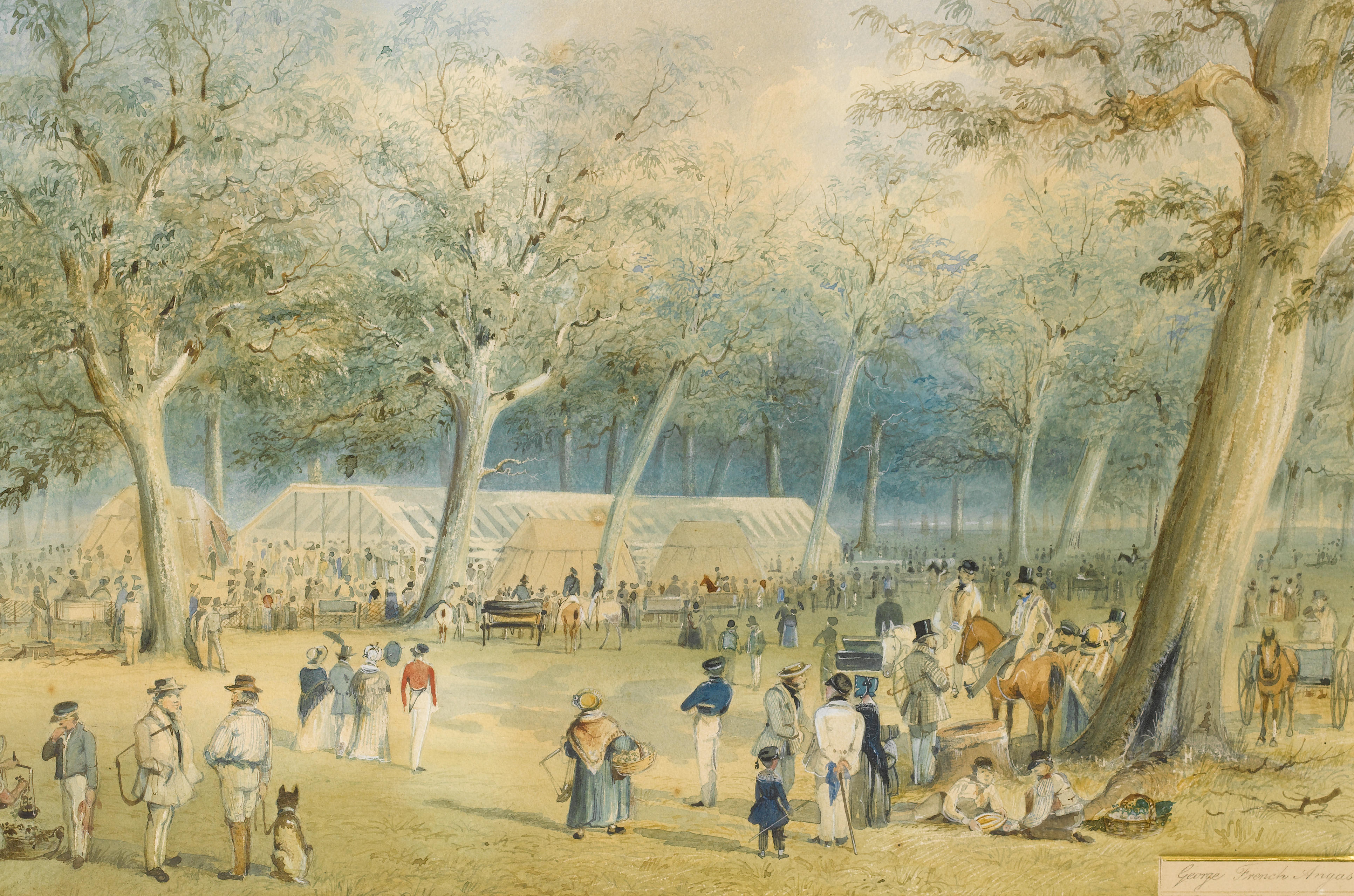 The Flower Show | National Gallery of Australia 2012.25
The Flower Show | National Gallery of Australia 2012.25
Artist: Gill, S.T. | Date: 1845-02~ | Appleyard cat. n/a | 25.5(H) x 38.5(W) cm
Catalogue: S.T. Gill and George French Angas, 1844-1845
The Agricultural and Horticultural Exhibition was held in Adelaide on Friday 14 February 1845 on the Park Lands to the northeast of the city. This is a rear view of the exhibition showing the carriage entrance; behind is the 120 foot long main pavillion and three smaller marquees set amongst the gum trees. In 1845, the carriage entrance was "at the gate on North Terrace, at the corner of the Frome Bridge Road." In this scene a four-wheel carriage arrives accompanied by two mounted policemen - likely that of the Governor, George Grey.
Gill painted rear views such as this one (showing the carriage entrance) and also front views. It is unusual for Gill that Aboriginal people are missing from this picture.
This painting has excellent provenance from the family of George French Angas.
A man is prominent near centre foreground, wearing a white suit and dark cap and holding a cane and blue scarf behind his back. It is Angas himself. (The appearance is very much like the 1848 lithograph portrait of Angas.) The child beside Angas is "Charlie". The man with the dog on a lead could well be Gill (compare AGSA 0.648).
In his diaries, W.A. Cawthorne wrote on 15 February 1845, describing this very scene and reporting the start of his studentship under S.T. Gill:
"Saturday Morning Feb 15. Yesterday ... the great agricultural show of this colony came off. Hundreds were present. The show was under a canvas pavilion erected in a [rural?] spot of the Park Land about ½ mile from our house. A great abundance of fruit was there – wool – a [piece?] of manufactured cloth – a cast bell – steam engine 4 horse power – a fine sun dial and stand – all colonial – tobacco, wheat, barley, onions, tomatoes, potatoes (immense), melons of all descriptions, candles, maize, soap, wine, cheese, butter &c &c. The greatest display was in fruit. Upon the whole there was a greater variety of articles this year but not so large a quantity of each as last year. The Governor distributed the prizes. All & every one as the lawyers say of the respectability was present. I saw Angas – but he was [fainting?] about Charlie who would take no notice of him [?]. I have this morning visited an artist to see whether he will take and learn me painting. He asks 12g. per annum.
"Saturday. I have drawn a rough sketch to show my future master (Mr Gill) on Monday. Oh! ye Gods grant that it may please and be the means of lowering his high price and become within the limited range of my pocket ammunition. Grant it Jupiter for Plutus' sake. Amen."
Philip Jones identifies "Charlie" as Charles Lord (Jones 2021, 19).
It is very likely that Gill painted this for Angas who went on to show it in his April 1846 London exhibition as "142. Annual Horticultural Show, in the Park Lands, Adelaide".
For more detail see the catalogue / main entry.
Map | S. T. Gill - Adelaide
337
Sturt's overland expedition leaving Adelaide 1844 | National Gallery of Australia 2012.1307
Artist: Gill, S.T. | Date: 1845-02~/1845-06~ | Appleyard cat. 80.3 | 24.8(H) x 38.4(W) cm
Catalogue: S.T. Gill and George French Angas, 1844-1845
The scene is the departure from Adelaide of Charles Sturt's Great Northern Expedition on 10 August 1844 ("side-on" view).
The cavalcade is proceeding from Grenfell Street at the right of picture and turning into and continuing north along King William Street. The view is northeast, looking from a vacant block (acre 140) diagonally across the intersection to Montefiore's store (acre 108), behind and to the right of which are the South Australian Company buldings on Rundle Street (acre 44).The building at right is Montefiore's house. (Noticably absent from this picture are Gill's street dogs.)
This "side-on" view differs from the "head-on" view of AGSA 0.644 and predates the King William Street premises (acre 79) of surgeon dentist Robert Norman built between April and July 1845.
This painting has excellent provenance from the family of George French Angas. It is very likely that Gill painted this for Angas who went on to show it in his April 1846 London exhibition as "144. Starting of Captain Sturt from Adelaide, on his Expedition into the Interior, in August 1844". Angas departed Adelaide for Sydney and London on 2 July 1845. I think this painting was painted after Angas' 22 January 1845 return to Adelaide and before completion of Norman's.
There are two top-hatted gentlemen in a two wheeled vehicle, with the near man in the grey coat probably being Governor George Grey. That being the case, the other man could be Captain O'Halloran, Grey's Private Secretary. These gentlemen also appear in AGSA 0.1128.
There are two chickens and a rooster – a device frequently used by Gill. See Klemzig, Angas, a German Hay Wagon and Chickens.
For more detail see the catalogue / main entry.
Map | S. T. Gill - Adelaide
252
[Spear & net fishing from a canoe and from the riverbank] | Mitchell Library, State Library of New South Wales PX*D 73 f.1
Artist: Gill, S.T. | Date: 1844-05~ | Appleyard cat. 35 | 19.6(H) x 30.3(W) cm
Catalogue: S.T. Gill, E.J. Eyre, Symmetry 1844
This picture illustrates Aboriginal fishing methods, probably, given the context, as originally observed at Moorunde. Three Aboriginal people – one of whom is a bearded man – fish with rod, line and float from a log on the river bank. Four women are seated in the canoe. Another person (probably a man) stands in the canoe with spears and a pole for fishing. A sixth person squats over a net.
This watercolour is identified as being for E.J. Eyre, based on subject matter, date and being one of eight in a library catalogue group in which four have a reverse inscription: "– Eyre Esqr –".
This subject is treated in Eyre's book. "At the period of the floods, and when they have nearly attained their height, and the young reeds and rushes begin to shew themselves above the surface of the water, near the bank of rivers or of lagoons formed by the floods in the alluvial flats behind, another method of spearing fish is practised from a canoe (mun) made out of a solid sheet of the bark of the gum-tree (eucalyptus) ..." Eyre, 263.
"I have never seen the natives use hooks in fishing of their own manufacture, nor do I believe that they ever make any, though they are glad enough to get them from Europeans." Eyre, Vol. 2, 266-7.
George French Angas' 1846 London exhibition included a work of a similar description: No. 161.14 "Murray River, natives spearing fish in a bark canoe".
43
Aborigines and white men hunting kangaroos | National Library of Australia NK1196
Artist: Gill, S.T. | Date: 1844-06~/1845-06~ | Appleyard cat. n/a | 24(H) x 37.1(W) cm
Catalogue: S.T. Gill and George French Angas, 1844-1845
Aboriginal men and two colonists hunt kangaroos from scrub at the bottom of a hill running onto a broad grassy flat. One of the white men has a kangaroo dog; the other fires a gun.
This work may correspond to Angas' London exhibition no. 207 "Kangaroo hunting in the scrub, near Moorundi".
In April 1851 Angas had for sale in Melbourne a work titled "Kangaroo Shooting, South Australia" (Empire, 18 April 1851: 3 <http://nla.gov.au/nla.news-article60034199>).
These references, combined with the absence of a known Angas equivalent, suggest the London and Melbourne pictures were this unsigned work by Gill.
122
 Extinct Crater, North of Spencer Gulf, South Australia | Art Gallery of South Australia 0.614
Extinct Crater, North of Spencer Gulf, South Australia | Art Gallery of South Australia 0.614
Artist: Gill, S.T. | Date: 1845 | Appleyard cat. 27.1 | 17.8(H) x 28.5(W) cm
Catalogue: S.T. Gill and George French Angas, 1844-1845
The view is of a rock formation seen on Captain E.C. Frome's 1843 northern expedition, which at the time was thought to be a volcanic crater. Two expeditioners and two Aboriginal people are in this scene.
Gill's original image is likely based on Frome's watercolour. Gill did an early version of this scene for E.J. Eyre (SLNSW-M PX*D 73 f.5).
For more detail see the catalogue / main entry.
198
...
David Coombe. Original November 2021. Updated 17 October 2025. | text copyright (except where indicated)
CITE THIS: David Coombe, 2021-2025, George French Angas in London and S.T. Gill, accessed dd mmm yyyy, <https://coombe.id.au/S_T_Gill/George_French_Angas_in_London_and_S_T_Gill.htm>